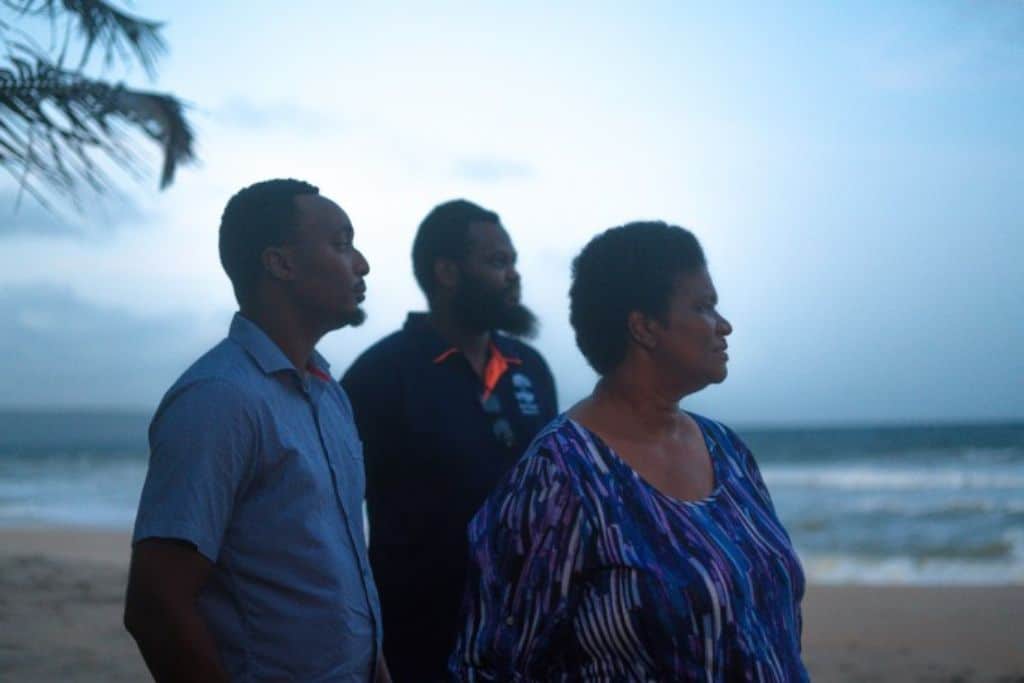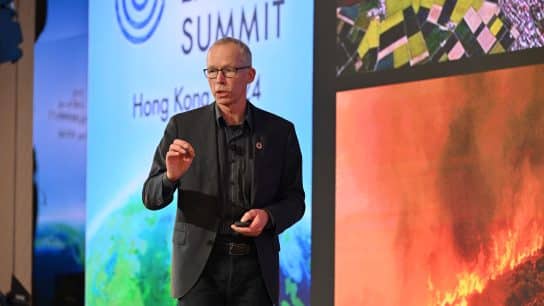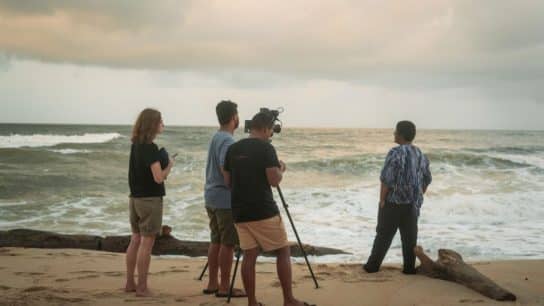In an exclusive interview with Earth.Org, Emmy-award winner and founder of Age of Union Dax Dasilva announced his latest YouTube series, “On the Frontline”, while also discussing the unique, important place that filmmaking has in the conservation of our planet. Utilizing filmmaking, Dasilva has empowered and brought attention to Age of Union’s worldwide conservation initiatives, producing five other film projects in the past, and garnering support for some of the Earth’s most trying issues. As a result of Age of Union and Dasilva’s concerted filmmaking efforts, France has been ordered to establish no-fishing zones in the Atlantic, as well as implement a means to protect dolphin populations. In addition, 25 land titles have been acquired in the Congo. In light of their continued success, Dasilva is wasting no time producing three more conservation films, while also establishing a new platform called “Age of Union Studios.”
—
Films about the environment often captivate and inspire their audiences in ways that other films fail to achieve. Take Al Gore’s “An Inconvenient Truth”, for example. In the decade that followed its critically-acclaimed release, sales in the solar power generation industry increased by 6,800%, the Paris Agreement was signed, Google searches for “climate change” and other topics skyrocketed, and most importantly, global discourse surrounding the topic of climate change was suddenly achieved, bringing the discussion of “what can we do to help?” to dinner tables thousands of miles apart.
Unfortunately, the film industry has experienced a recent decline in productions related to climate change, though people are demanding an increase. A 2022 study conducted by USC researchers found that 48% of climate-conscious viewers wanted more shows and films with themes related to global warming. In addition, those who felt hopeful about climate solutions were 3.5 times more likely to have the desire to view more climate narratives on their TV’s.
You might also like: The 21 Best Environmental Films to Watch in 2024
Which is why it should be of no surprise that environmental activists such as Emmy award-winning executive producer, Dax Dasilva of Age of Union, a non-profit environmental alliance, feel the need to fill that gap, joining the ranks of other conscientious filmmakers who choose to spread information about the climate crisis and solutions.
On January 26, 2024, Dasilva, released “On the Frontline”, a YouTube series highlighting the important work being accomplished by dedicated environmentalists in locations from Canada to Trinidad. In an exclusive interview with Earth.Org, Dasilva shares what his newest film series is all about, why he has chosen film as one of his mediums to affect change, and where he sees Age of Union and its place in the film industry going in the future.
“People often ask me when I’ve come back from these trips: ‘Don’t you feel depressed about the environment?’ For me it’s the opposite. When I go to the frontline, I see things happening in a positive direction,” said Dasilva.
He said the whole point of “On the Frontline” was to showcase the positive side of conservation efforts – the work being accomplished, rather than the destruction being caused – and to inspire others to conserve and protect remote locations they may not have access to.
“I think that that’s what we wanted to do with this series… We wanted to bring people to the front line of our projects and make them real to people that can’t get to some of these places.” said Dasilva. “If you want to know what it takes to save a species or to save a place this is what you’re gonna see in [the series].”

The first and second episodes follow Suzan Lakhan Baptiste, managing director of Nature Seekers, a community-driven non-profit located on Matura beach of Trinidad, and her team of conservationists, fighting to protect a large population of leatherback sea turtles.
“[Baptiste] grew up in Matura beach, and saw these majestic creatures coming up during the nesting season, laying their eggs and returning to the ocean… Only one in 1,000 of those eggs will actually make it to breeding,” explained Dasilva.
“30 years ago, she also saw young men coming on to those beaches, poaching these mother turtles for meat and stealing their eggs. It was a graveyard. So she started fighting. She viscerally got involved with this incredible fight. And through the next 30 years she converted that whole community into a conservation, ecotourism community.”
“My local people are now the conservationists-they are now the protectors,” said Baptiste in an excerpt from the YouTube series.
Though the leatherback sea turtle, a truly unique, 2,000-pound, deep sea-diving (4,000 feet) gentle giant may seem like a creature far removed from the ecosystems of the Western world, one of their migratory paths actually follows the coast of Newfoundland, Canada, all the way from Matura beach in Trinidad. While they follow this path, they consume jellyfish, growing in size by as much as two to three times their original weight (reason for which they have leathery, flexible backs that expand). Utilizing these stored calories, leatherback turtles produce anywhere from 85 to 95 tennis ball-sized eggs, and then lay them on Matura beach.
“There’s a real impact to humans when [their populations] declined, because they are the main predator of jellyfish. If you’ve heard that there’s an overabundance of jellyfish in the ocean… that’s because turtle populations [are declining],” explained Dasilva.
“What does the jellyfish prey on? The jellyfish preys on small, baby fish. So if the jellyfish eats all the small baby fish, we have no fish. The leatherback turtles help our fisheries – they keep fish populations healthy – and so it’s in our interest to make sure that they are doing that job, because there’s very few other predators that do clear out the jellyfish or reduce their population.”
As vital as the work in Trinidad is, Age of Union is also heavily dedicated to conservation efforts in other areas of the world, including Peru, the Atlantic, the Congo, the Amazon, and of course, their homeland, Canada, via the Saint Lawrence river. Utilizing the power of film, Dasilva believes that people can be motivated to fight for these causes, whether it be in their backyard or across the planet.
“Film is important because it can bring people to a place, to a situation, to the reality of a challenge that we’re having with saving a species or saving a place…And the ability to capture that story, to capture the human emotion behind doing that work, and the struggle of it and the wins that are experienced, too. To bring that to people everywhere is ultra powerful.” explained Dasilva.
Since the inception of Age of Union in October of 2021, Dasilva has funded and released five other films to inspire, educate, and most importantly show people exactly what they are doing, up close and personal.
Amazingly, just as Dasilva hoped, their filmmaking efforts have garnered attention for many of their causes across the world, and in so doing, have inspired not only a call to action, but action itself. As a result of their documentary “CAUGHT” – an eye-opening revelatory film exposing the fishing and bycatch industries contributing to the destruction of oceanic ecosystems in the Atlantic – and the efforts of Sea Shepherd France, the Council of State ordered the French government to establish no-fishing zones, and to implement a means to protect dolphin populations in the Atlantic. Furthermore, “The Corridor”, a documentary centered on the gathering of 21 land titles in the Congo to establish a corridor of protected land, led to the acquisition of an astounding 25 land titles.
“Everybody can learn from Congo. They truly have found a model that’s gone viral. Chiefs from surrounding communities were coming to this town hall using chalk to delineate the different land titles… people were coming to this meeting to beg for their area to be added to this process. And that’s how we’ve gotten to 25. Because everybody wants in, because not only does it provide the land title, which provides the wood, which provides for their building and for their charcoal and keeps people out of the gorilla parks, but it also keeps all the mining from coming into their area,” said Dasilva.
Given the success that the filmmaking process has provided Age of Union and their conservation efforts, Dasilva has established a separate entity called Age of Union Studios, where they can invest in long-form film projects being developed by other filmmakers. In addition, this year, Dasilva and Age of Union will be executive producing three film projects: “The Snake Rescuer’s Son”, their second feature documentary in collaboration with the team behind “Wildcat” – the story of a father and son who work together to protect wildlife in South India, an unannounced project with Malaika Picture’s latest film (will be announced later this year), and a project with National Geographic’s Impact Story Lab.
“Film possesses an unparalleled capacity to evoke emotion, challenge perspectives, and inspire change,” Dasilva wrote on the Age of Union website. “At Age of Union, we believe in the profound influence of cinema to not only grab people’s attention but to serve as a catalyst for positive change on a global scale.”
Featured image: Age of Union.
You might also like: Age of Union and Jane Goodall’s Legacy Foundation Form Partnership to Protect the Amazon Rainforest


















